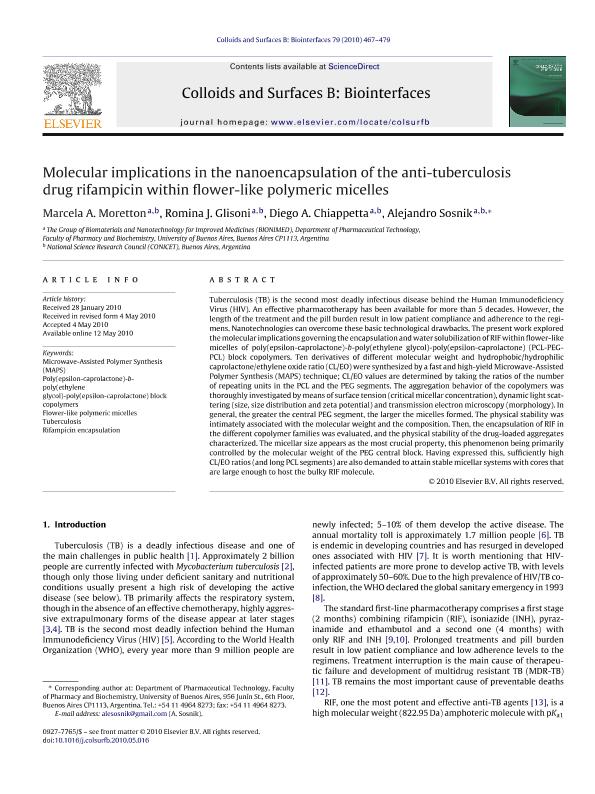Artículo
Molecular implications in the nanoencapsulation of the anti-tuberculosis drug rifampicin within flower-like polymeric micelles
Moretton, Marcela Analía ; Glisoni, Romina Julieta
; Glisoni, Romina Julieta ; Chiappetta, Diego Andrés
; Chiappetta, Diego Andrés ; Sosnik, Alejandro Dario
; Sosnik, Alejandro Dario
 ; Glisoni, Romina Julieta
; Glisoni, Romina Julieta ; Chiappetta, Diego Andrés
; Chiappetta, Diego Andrés ; Sosnik, Alejandro Dario
; Sosnik, Alejandro Dario
Fecha de publicación:
09/2010
Editorial:
Elsevier Science
Revista:
Colloids and Surfaces B: Biointerfaces
ISSN:
0927-7765
Idioma:
Inglés
Tipo de recurso:
Artículo publicado
Clasificación temática:
Resumen
Tuberculosis (TB) is the second most deadly infectious disease behind the Human Immunodeficiency Virus (HIV). An effective pharmacotherapy has been available for more than 5 decades. However, the length of the treatment and the pill burden result in low patient compliance and adherence to the regimens. Nanotechnologies can overcome these basic technological drawbacks. The present work explored the molecular implications governing the encapsulation and water solubilization of RIF within flower-like micelles of poly(epsilon-caprolactone)-b-poly(ethylene glycol)-poly(epsilon-caprolactone) (PCL-PEG-PCL) block copolymers. Ten derivatives of different molecular weight and hydrophobic/hydrophilic caprolactone/ethylene oxide ratio (CL/EO) were synthesized by a fast and high-yield Microwave-Assisted Polymer Synthesis (MAPS) technique; CL/EO values are determined by taking the ratios of the number of repeating units in the PCL and the PEG segments. The aggregation behavior of the copolymers was thoroughly investigated by means of surface tension (critical micellar concentration), dynamic light scattering (size, size distribution and zeta potential) and transmission electron microscopy (morphology). In general, the greater the central PEG segment, the larger the micelles formed. The physical stability was intimately associated with the molecular weight and the composition. Then, the encapsulation of RIF in the different copolymer families was evaluated, and the physical stability of the drug-loaded aggregates characterized. The micellar size appears as the most crucial property, this phenomenon being primarily controlled by the molecular weight of the PEG central block. Having expressed this, sufficiently high CL/EO ratios (and long PCL segments) are also demanded to attain stable micellar systems with cores that are large enough to host the bulky RIF molecule.
Archivos asociados
Licencia
Identificadores
Colecciones
Articulos(OCA HOUSSAY)
Articulos de OFICINA DE COORDINACION ADMINISTRATIVA HOUSSAY
Articulos de OFICINA DE COORDINACION ADMINISTRATIVA HOUSSAY
Citación
Moretton, Marcela Analía; Glisoni, Romina Julieta; Chiappetta, Diego Andrés; Sosnik, Alejandro Dario; Molecular implications in the nanoencapsulation of the anti-tuberculosis drug rifampicin within flower-like polymeric micelles; Elsevier Science; Colloids and Surfaces B: Biointerfaces; 79; 2; 9-2010; 467-479
Compartir
Altmétricas



